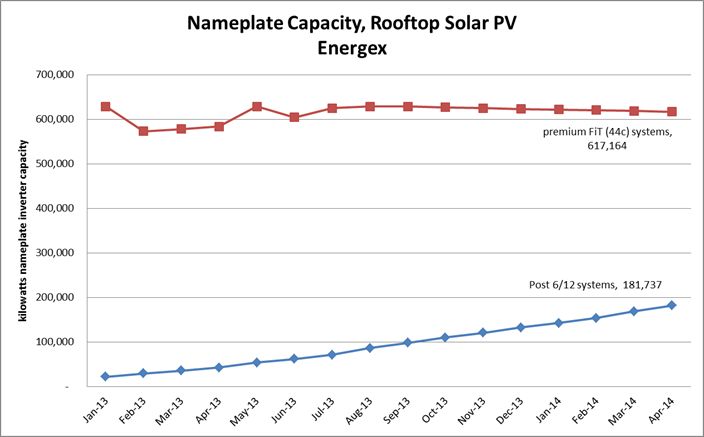Queensland's ultra-smooth quarter-million solar roofs
The electricity network business serving southeast Queensland, Energex, expects this week it will have connected a quarter of a million solar PV systems to its network.
Energex is finding that even though the government has slashed the price solar owners are paid for their electricity, down from 44 cents per kilowatt-hour to just 8 cents, installations are still running at a reasonable clip.
As of April, 20 per cent of all solar generating capacity will now have been installed without receiving a major premium over wholesale market electricity prices.
Meanwhile, systems receiving the 44 cent premium are slowly declining as houses change ownership (eligibility for the 44 cent premium rate is lost when the house changes ownership). According to Energex about 700 systems per month drop off the 44 cent premium, helping to reduce the cost of this government support program.

Source: Energex
Energex is, to a large extent, proving what many didn’t think possible just a few years ago. In a number of sections of its network it is managing solar PV capacity as high as 50 per cent of local demand without making dramatic changes to network infrastructure.
While Energex has seen voltages rise noticeably in areas where large amounts of solar have been installed, for the most part these have been able to be managed by manual adjustments to step down the voltage settings of their transformers to compensate (known as ‘tap changes’). This has largely avoided the need for expensive upgrades of physical network equipment and has been managed without the rollout of what is often considered smart-grid infrastructure, such as smart meters (although this would help make it easier).
Some lobbyists representing energy suppliers have tried to suggest the large growth in installations of solar PV have imposed significant costs in network infrastructure upgrades (for example, the Energy Supply Association).
On this point the Energy Networks Association, which is the primary lobby group for electricity network businesses, released a publication last week on issues surrounding connecting embedded generation. The report is far from enthusiastic about the growth of solar PV and suggests support for the technology should be withdrawn.
It highlights a number of technical issues that need to be managed with integrating embedded generation including power voltage and quality, and network safety and protection.
Yet the report ultimately notes that, “In many cases, these and other issues may be manageable with simple or low cost responses.”
That is what Energex has shown, and what a range of other network operators are also finding.
This is not to say that adding solar PV capacity will in all cases be manageable without costly upgrades to network equipment. In remote locations with long feeder lines and urban areas with old network equipment, integrating solar PV systems can be more challenging.
However, network businesses aren’t powerless to control these costs. The ENA notes in its report:
“Networks still require the ability to assess proposed solar PV connections, to avoid compromising network efficiency and impacting on voltage levels outside statutory ranges. The network may need to downsize or decline an application if it presents risks to the network or to individual premises.”
Where the addition of solar PV is likely to require noticeable network infrastructure costs these are usually imposed on the premise installing solar, not other customers.
















